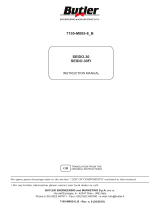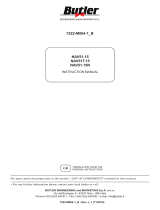
INSTRUCTION, USE AND
MAINTENANCE MANUAL
Page 2 of 36
GB
SUMMARY
SYMBOLS USED IN THE MANUAL AND
ON THE MACHINE ________________________ 4
1.0 GENERAL INTRODUCTION __________ 6
1.1 Introduction ____________________________ 6
2.0 INTENDED USE _____________________ 6
2.1 Training of personnel __________________ 6
3.0 SAFETY DEVICES ___________________ 7
3.1 Residual risks __________________________ 7
4.0 GENERAL SAFETY RULES __________ 7
5.0 PACKING AND MOBILIZATION FOR
TRANSPORT ________________________ 8
6.0 UNPACKING _________________________ 9
7.0 MOBILIZATION ______________________ 9
8.0 WORKING ENVIRONMENT CONDI-
TIONS ______________________________ 10
8.1 Working position ______________________10
8.2 Installation space _____________________10
8.3 Lighting _______________________________10
9.0 ANCHORING SYSTEM ______________ 10
10.0 ASSEMBLY AND PREPARATION FOR
USE ________________________________ 11
10.1 Assembly procedures _________________11
10.2 Post assembly _________________________11
10.3 Bead breaker arm mounting __________11
10.4 Tubeless inflation mounting (only for
versions with tubeless inflation) ______11
10.5 Electrical connections _________________12
10.6 Check of motor rotation direction _____13
10.7 Air connection _________________________13
10.8 Controls _______________________________13
11.0 CONTROLS _________________________ 14
11.1 4 pedals control unit __________________14
11.2 Inflation pedal (on demand) ___________14
11.3 Additional pedal for devices with
tubeless inflation _____________________14
11.4 Post handle manual adjustment _______15
12.0 USING THE MACHINE ______________ 15
12.1 Precaution measures during tyre re-
moval and fitting ______________________15
12.2 Preliminary operations - Preparing
the wheel ______________________________15
12.3 Bead breaking _________________________16
12.4 Wheel clamping on the mandrel _______17
12.5 Demounting ___________________________18
12.6 Setting the tool for tyre fitting and
removal _______________________________19
12.6.1 Setting the clamps travel
__________19
12.6.2 Setting the tool for tyre fitting
and removal _______________________20
12.7 Adjusting descent of the hexagonal
shaft (on demand) _____________________21
12.8 Mounting the tyre _____________________22
12.9 Tyre inflation__________________________23
12.9.1 Tyre inflation with pressure
gauge (on demand)_________________23
12.9.2 Tubeless tyre inflation device
______23
13.0 ROUTINE MAINTENANCE __________ 24
13.1 Lubricants ____________________________26
14.0 TROUBLESHOOTING TABLE _______ 27
15.0 TECHNICAL DATA __________________ 28
15.1 Dimensions ____________________________29
16.0 STORING ___________________________ 30
17.0 SCRAPPING ________________________ 30
18.0 REGISTRATION PLATE DATA ______ 30
19.0 FUNCTIONAL DIAGRAMS __________ 30
Table A - 3 phase single speed motor wiring
diagram (HP441S.18 - HP441S.20
- HP441S.22 - HP441S.20FI -
HP441S.22FI) _____________________31
Table B - 3 phase double speed motor
wiring diagram (HP441SQ.18
- HP441SQ.20 - HP441SQ.22 -
HP441SQ.20FI - HP441SQ.22FI)
__
37HP645D.XXFI - HP645Q.XXFI) __33
Table C - Pneumatic circuit diagram
(HP441S.XX-HP441SQ.XX)
________35
Table D - Pneumatic circuit diagram
(HP441S.XXFI - HP441SQ.XXFI)
___36
20.0 LIST OF COMPONENTS
7300-M023-0_B
HP441S.XX - HP441S.XXFI
HP441SQ.XX - HP441SQ.XXFI






























